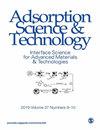Investigation of the Zeta Adsorption Model and Gas-Solid Adsorption Phase Transition Mechanism Using Statistical Mechanics at Gas-Solid Interfaces
IF 3.2
4区 工程技术
Q2 CHEMISTRY, APPLIED
引用次数: 0
Abstract
This review examines the significance of the zeta adsorption model in physics and its integration with statistical mechanics within the field of interface adsorption. Through a comprehensive analysis of existing research, this study presents the collective findings and insights derived from the reviewed literature. The zeta adsorption model, proposed by Ward, has gained recognition for its seamless extension into the thermal disequilibrium region without encountering singularities. By incorporating principles from quantum mechanics and statistical thermodynamics, this model offers fresh perspectives on the adsorption of gas molecules on solid surfaces. Notably, it demonstrates enhanced accuracy in describing the adsorption performance of mesoporous materials and nanomaterial surfaces, surpassing the limitations of traditional models such as the BET isotherm. Additionally, this review explores the behavior of cluster formation under varying temperature and pressure conditions. It highlights the correlation between increasing pressure ratios and the decreased availability of empty adsorption sites, resulting in the formation of larger clusters within the adsorbate. Ultimately, this process leads to a transition from adsorption to condensation, where the liquid phase wets the solid surface. Moreover, the zeta adsorption model provides a solid theoretical foundation for understanding crucial aspects of gas-solid interface adsorption. It enables the determination of the distribution of adsorbate clusters on gas-solid interfaces, facilitates the identification of wetting pressure ratios during phase transitions, and allows for the calculation of solid surface tension under conditions of zero adsorption. Noteworthy parameters such as the bonding strength (β) between the solid surface and adsorbed atoms significantly influence the overall strength of the solid-fluid interaction. Furthermore, the phenomenon of surface subcooling, which necessitates sufficient energy for the transformation from adsorbed vapor to condensate liquid, plays a pivotal role in studying interface phase transitions. Additionally, this review investigates the thermodynamic stability of the adsorbate through an analysis of molar latent heat. It reveals that beyond a critical adsorbate coverage, the formation of critical-sized clusters and the ensuing interactions among these components render the adsorbate unstable. This instability prompts a transition from the interface to a liquid phase, followed by subsequent adsorption onto the surface. In summary, this literature review highlights the significant contributions of the zeta adsorption model to the field of physics, particularly in the context of interface adsorption. It serves as a valuable tool for studying various materials and cluster formation, thanks to its seamless extension into the thermal disequilibrium region and its incorporation of principles from quantum mechanics and statistical thermodynamics. By presenting a synthesis of existing research, this review sheds light on the advantages of the zeta adsorption model and paves the way for further investigations into gas-solid interface adsorption phenomena.气固界面Zeta吸附模型及气固吸附相变机理的统计力学研究
本文综述了zeta吸附模型在物理学中的意义,以及它与统计力学在界面吸附领域的结合。通过对现有研究的综合分析,本研究提出了从文献综述中得出的集体发现和见解。Ward提出的zeta吸附模型因其无缝延伸到热不平衡区而没有遇到奇点而得到认可。通过结合量子力学和统计热力学原理,该模型为固体表面气体分子的吸附提供了新的视角。值得注意的是,它在描述介孔材料和纳米材料表面的吸附性能方面表现出更高的准确性,超越了传统模型(如BET等温线)的局限性。此外,本文还探讨了不同温度和压力条件下团簇形成的行为。它强调了压力比的增加与空吸附位点可用性的降低之间的相关性,从而导致在吸附质中形成更大的簇。最终,这个过程导致从吸附到冷凝的过渡,其中液相润湿固体表面。此外,zeta吸附模型为理解气固界面吸附的关键方面提供了坚实的理论基础。它能够确定吸附质团簇在气固界面上的分布,有助于确定相变过程中的润湿压力比,并允许计算零吸附条件下的固体表面张力。值得注意的参数,如固体表面和吸附原子之间的键合强度(β)显著影响固-流相互作用的总体强度。此外,表面过冷现象是研究界面相变的关键,它需要足够的能量才能从吸附蒸汽转变为冷凝液体。此外,本文还通过摩尔潜热分析研究了吸附质的热力学稳定性。它揭示了在临界吸附物覆盖范围之外,临界尺寸簇的形成以及这些组分之间随后的相互作用使吸附物不稳定。这种不稳定性促使从界面过渡到液相,随后在表面吸附。总之,这篇文献综述强调了zeta吸附模型对物理学领域的重要贡献,特别是在界面吸附方面。它是研究各种材料和团簇形成的有价值的工具,这要归功于它无缝地延伸到热不平衡区域,并结合了量子力学和统计热力学的原理。本文通过对现有研究的综合,揭示了zeta吸附模型的优点,为进一步研究气固界面吸附现象奠定了基础。
本文章由计算机程序翻译,如有差异,请以英文原文为准。
求助全文
约1分钟内获得全文
求助全文
来源期刊

Adsorption Science & Technology
工程技术-工程:化工
CiteScore
5.00
自引率
10.30%
发文量
181
审稿时长
4.5 months
期刊介绍:
Adsorption Science & Technology is a peer-reviewed, open access journal devoted to studies of adsorption and desorption phenomena, which publishes original research papers and critical review articles, with occasional special issues relating to particular topics and symposia.
 求助内容:
求助内容: 应助结果提醒方式:
应助结果提醒方式:


